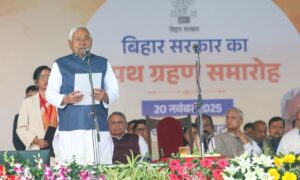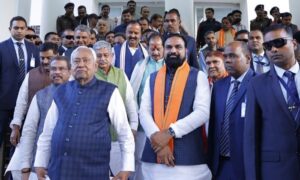
Photolabs@ORF
The Kashmir issue has two facets — domestic, and Pakistan’s role.
A team from the Centre for Peace and Conflict Studies (CPCS) Jaipur, Sardar Patel University of Police, Security and Criminal Justice, which had visited Kashmir recently, conducted a debrief at Observer Research Foundation on the escalating conflict and changing dimensions of insurgency in Kashmir. The debrief was followed by a discussion with research scholars. The team of serving officers had visited Kashmir as part of Executive Programme in Conflict and Security Studies. Study of terrorism and insurgency in Kashmir is an essential part of the module on ‘National and International Security’ of this executive programme. Since the formation of a task force on Kashmir in 2016, the CPCS has been closely researching various dimensions of Kashmir issue, and has given recommendations from time to time for prevention and conflict resolution. During their nine day visit to the Valley they interacted with various stakeholders including academicians, locals, Security Forces and the Governor. During the meeting a range of issues were discussed, including online propaganda, Islamic radicalisation, local militancy and the PDP-BJP alliance.
Internet penetration in the Kashmir valley has increased. A growing number of Kashmiris have access to smartphones and the internet. This has created two sets of issues. Firstly, platforms like WhatsApp are being used to mobilise protesters. Secondly, easy access to the internet has allowed the spread of ISIS type propaganda. Cyberspace has played a role in further fueling the conflict, it provides alienated youth a sense of belonging on the online platform. Subsequently, their involvement in the virtual world further alienates them from the positive elements of the physical society. It was argued the difference between the current situation and the situation in 2002 is that there is no desire a normal urban existence in the Valley. It was suggested that Islands of normality need to be created to bring back this desire. For instance, the shutdown of schools has left children idle at home, increasing the use of smartphones.
Online propaganda is just one of the several overlapping factors that has contributed to the disenchantment of young Kashmiris. The discussants pointed out that the state has not been able to create an effective counter narrative, an ideological reorientation. An increasing number of them have been involved in stone pelting at security forces. Moreover, it was observed that these protesting youth are deliberately disrupting anti-militancy operations. Questions were raised on the extent of Pakistan’s role in online propaganda. Several arguments were made. Firstly, some researchers pointed out that there is a stark difference between Pakistani content and online messages and the content viewed by Kashmiri youth. It seems that this content is therefore created by young locals who have no other positive avenues to channel their energies. It is imperative that the state develop speedy counter narratives online.
Another major aspect of the discussion was the alliance between PDP and BJP. There is popular discontent in the Valley as Kashmiris feel betrayed by PDP’s false promises. During its campaign, the PDP evoked a strong rhetoric against the BJP. Once an alliance was formed, the Agenda of Alliance promised a dialogue with Hurriyat, a discussion on the withdrawal of the AFSPA, the status of Article 370, and most importantly, relief and rehabilitation for the victims of the 2014 floods. There was no follow up on the agenda. It was pointed out that the agenda had been violated in letter and in spirit. It took the centre a good 14 months before it released a flood package and the rest of the commitments were not honoured.
Some scholars stated that conflict management is a priority, with so many kids out on the street, conflict resolution should be a secondary agenda. It was argued that while the conflict requires a political solution, a social resolution is lacking. The Kashmir issue has two facets, domestic and Pakistan’s role. There needs to be a synchronisation of the management of both these elements, since they are interdependent. For instance, to label a stone pelter as a terrorist would be wrong. If he is a terrorist, then there can be no negotiations. However, negotiations are possible with a stone pelter. Therefore, a clear distinction should be made between a terrorist and a stone pelter.
Furthermore, an important debate was raised on the rise of Islamic radicalisation in the Valley. The trend has accelerated in the past decade as ISIS type propaganda has proliferated on the internet. It was also argued that despite Islamisation efforts in the 90s, terror networks Al Qaeda and ISIS have not been able to create a strong foothold in Kashmir. During the first decade of the insurgency, there were debates on Islamisation. Today there is a general trend of orthodoxy in all religions across the world. So the two trends should not be confused with each other. It was pointed out that there must be a clear distinction between orthodoxy, fundamentalism and radicalism.
The psychological dimension was also brought up during the discussion. The sentiment of azadihas taken over the Valley. The Indian state must address this sentiment. It was pointed out that Pandit Nehru was able to handle this by giving Kashmiris their own constitution and flag. While those were symbolic gestures, they were powerful. It was argued that skillful policy making which recognises the local psychi would be a more enlightened form of management.
In conclusion, the state needs to work on faith building. This will require greater political dialogue, and engagement with the Kashmiri people. There should also be greater interaction between the governments in Delhi and in Srinagar. It was pointed out that to solve the issue of cyber propaganda, a policy can be implemented which mandates every cyber handle to a known address. The internet domain is a trigger point for street violence, in the past VPN bans have been counter intuitive and ineffective, therefore the government must work on strong counter narratives.
This report was prepared by Ashini Jagtiani and Dhananjay Sahai, research interns at Observer Research Foundation(ORF), New Delhi. The post was first published by ORF. Click Here.


















